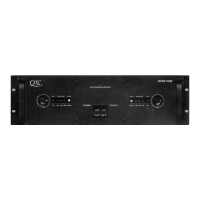30
b. Select a load resistance of 2.6 ohms. Vary the Gain to display a small amount of ordinary
voltage clipping (indicated by the presence of ripple at peaks of the output signal). Note: Check
that the red clip LED is working.
c. Adjust the current limit trimpots (T2 & T3) until the amp begins current limiting (ripple and
amplitude of peaks flatten) and then back off the pot slightly to the point where the amp just
shows full ripple.
d. Check the short circuit current (1.0 to 2.0 amps).
7. Crossover (bias) adjustment
a. Select an 8-ohm load.
b. Change the input frequency to 20kHz and decrease the input level to 20dB. Adjust the
crossover trimpot, T1, for 3 CM peak-to-peak of crossover spike protruding from the noise
signal on channel B of the oscilloscope. Note: The bias shouldn’t need adjusting unless the
amp is over-heating or the drivers have been changed.
8. 20kHz distortion
a. Select a 4-ohm output load.
b. Check that the distortion is no greater than 0.1% at all output levels from –20dB (1.3 watts) to
full output (at least 65W x 2)
9. 4 ohm power output and frequency response
a. Switch the distortion analyzer to volts/power. Select a 2kHz signal input to the amplifier.
b. Adjust the input signal to obtain 65 watts (x2) output and observe power output at 20Hz (-0.5dB
max.), and 20kHz (-0.5dB max.).
10. Temperature cycle
a. Switch to the 2.6-ohm load. Increase the signal to the point of clipping and short the output of
the amplifier. The clip LED should be on. Check for recovery into 2.6 ohms (cold).
b. Check the IC rails (5 to 7VDC & ±1VDC).
c. After 1 to 3 minutes the Temp LED should start flashing and 2 to 3 minutes later the
signal/mute relay should go off and the power/protect LED should turn red. Check (with
temperature probe) the turn-off temperature at the PTC. This temperature should be 100°C, ±
5°C. Check that the idle current is not more than 1.0 amps and that it decreases to less than
0.4 amps as the amplifier cools.
d. Cool the heatsink with a fan, (or less preferably, with freeze spray) and observe the short circuit
current limited operation (1.5 – 2.5A) into the shorted output (hot). Test the amplifier recovery
from a short into a 2.6-ohm load.
e. Set the load resistance to 8 ohms. Decrease the input signal and check for presence of a step
glitch at 50W, ± 10W.
11. Final Check
a. With the load resistance at 8 ohms, see that distortion does no exceed 0.1% at 20kHz from
110W to 1.1W (-20dB).
b. For the signal to noise test, adjust the output for 110W (-0.5dB). Remove the input signal and
measure the noise level. The noise level must be no more than 5mV on the oscilloscope.
c. Reduce the Variac voltage. Observe the relay dropout at about 20VAC (± 10V).

